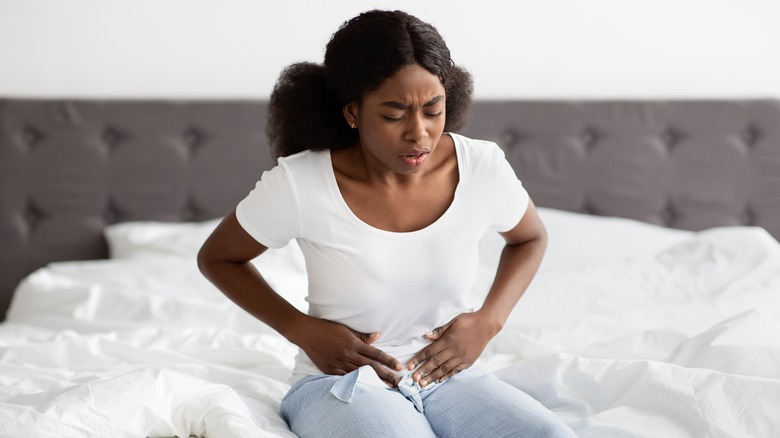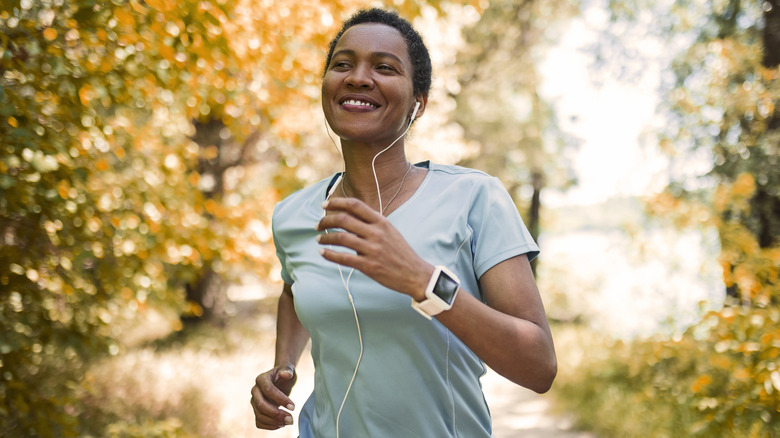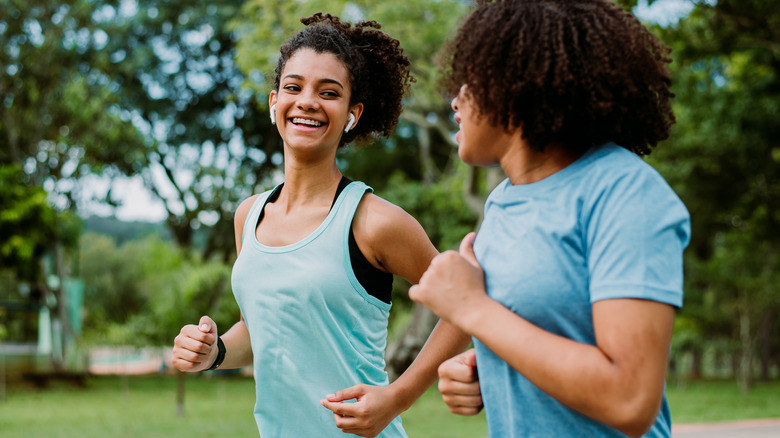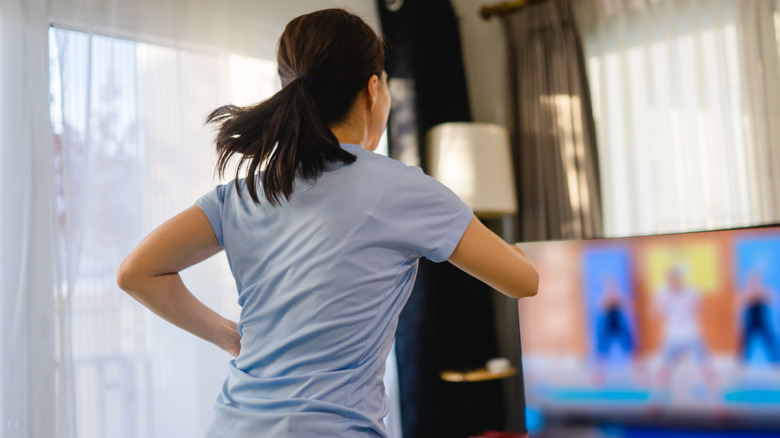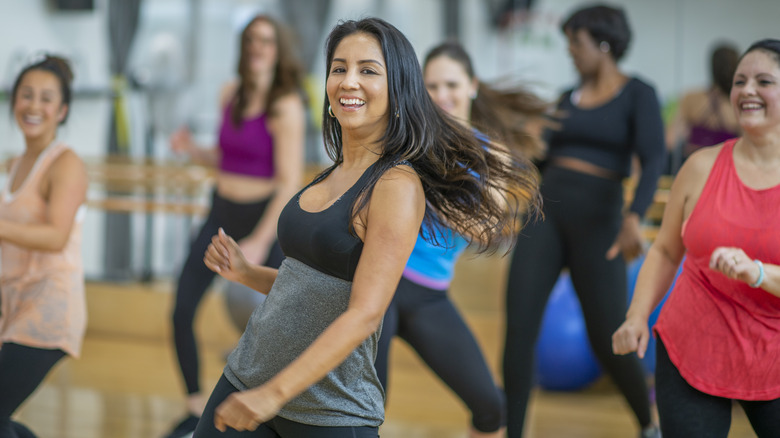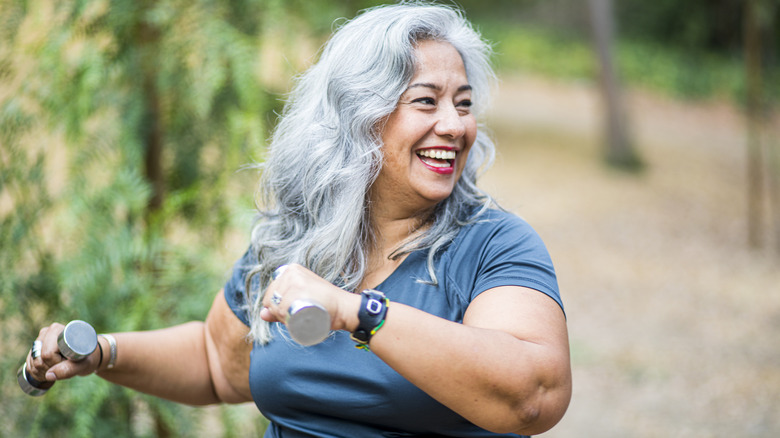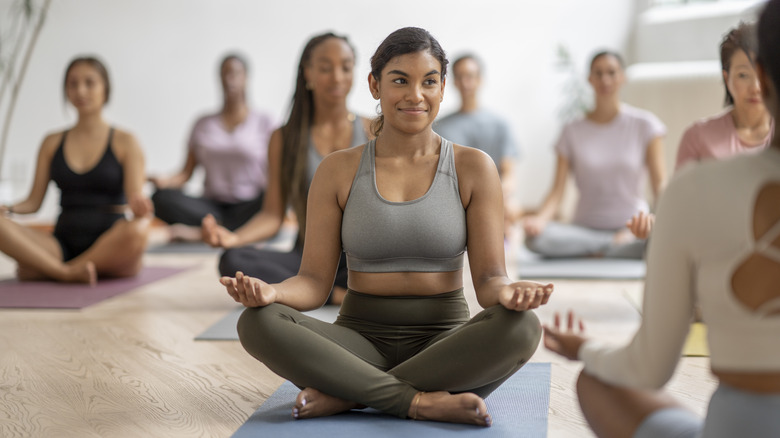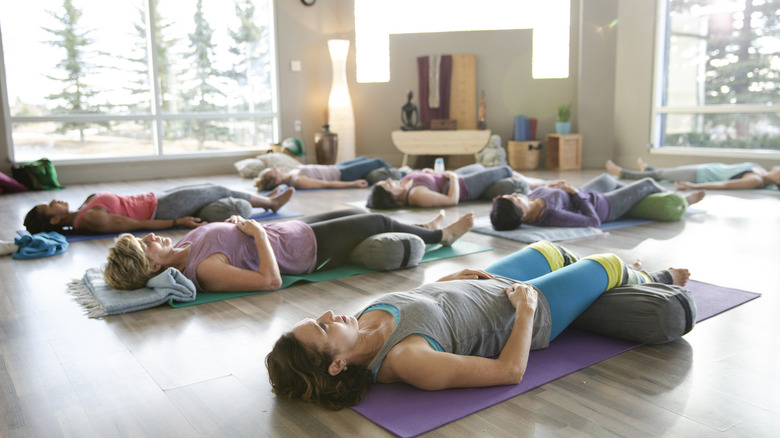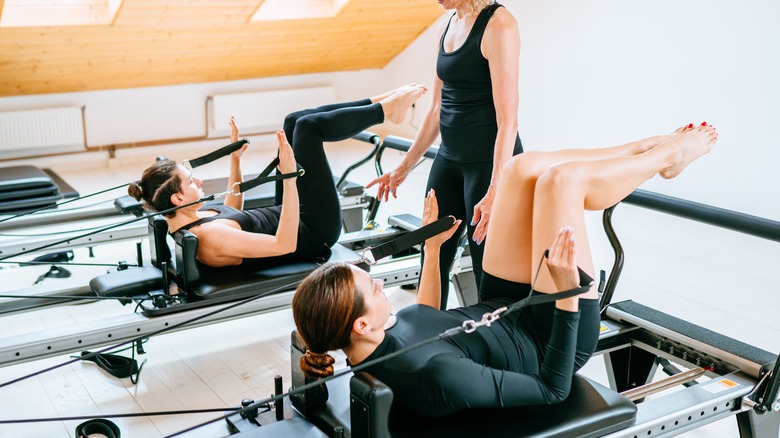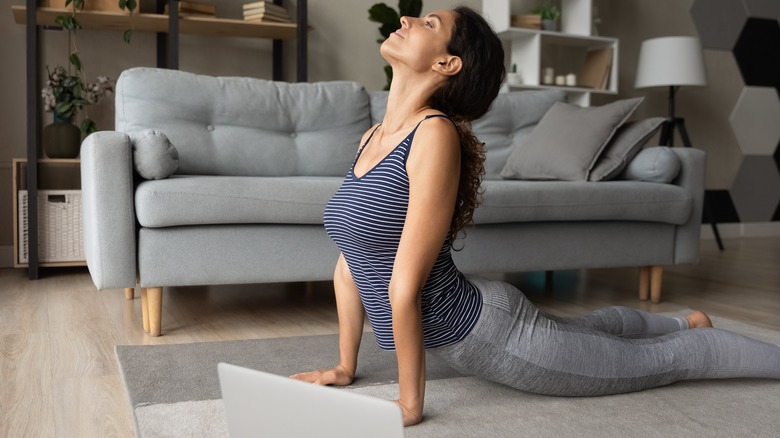10 Exercises & Movements That Put Period Cramps On Pause
Around the time of your period, exercise may be the last thing you feel like doing. This is especially true if you have painful menstrual cramps. Many people deal with cramps, and 20 percent of menstruating people experience cramping so severe that it interferes with their daily activities (via American Family Physicians). Whether yours are mild or severe, they can really put a damper on your urge to make it to the gym after work. However, it also might be a good idea to fight the urge to face plant on the couch and instead lace up your tennis shoes. Research shows that regular exercise can actually reduce the pain of menstrual cramps. Walking, jogging, yoga, swimming, and stretching are all good choices for your workouts when you have menstrual pain. And, if you have the extra energy, you can even push the intensity up a notch or two and still reap the effects. However, keep in mind that every person's body is different, as is every person's experience of menstrual cramps. Whatever exercise you choose, just know that listening to your body should be your top priority. We've gathered together some options that have been shown to help period pain — but, ultimately, you have to choose what activity feels best for you.
How exercise helps period cramps
You know that special high you feel after a good workout? It's due to chemicals in your brain called beta-endorphins that are released during exercise (via WebMD). Also referred to as "feel-good" chemicals, endorphins have pain-relieving effects and also have properties similar to the drug morphine (via the National Institutes of Health). Endorphins also help to reduce levels of compounds called prostaglandins, produced in the body in higher amounts around the start of your period. Prostaglandins cause the muscles and blood vessels in the uterus to contract, or cramp. Endorphins act much like non-steroidal anti-inflammatory drugs (NSAIDs), which also help reduce prostaglandins (via the American Academy of Obstetricians and Gynecologists). To boost endorphins, you have to exercise at a level that raises your heart rate and makes you sweat a bit.
There are other mechanisms behind exercise's effectiveness in reducing menstrual pain that are still not well understood. Strengthening and stretching the abdominal and pelvic muscles may help. Moreover, exercise is an effective way to reduce stress, which can relieve period pain. According to Harvard Health Publishing, exercise lowers levels of stress hormones like cortisol and adrenaline, and increased stress is linked with increased risk and severity of menstrual cramps. A 2004 study showed that those with high levels of stress were twice as likely to experience period pain as those with lower stress levels.
Walking and jogging
Walking and jogging are the simplest ways to get your heart rate up and get those endorphins going. In a 2020 study of pre-menstrual respondents, those who walked on a treadmill in addition to performing breathing exercises had significantly less abdominal pain than those who only performed the breathing exercises alone. Unless you're living with a condition that prevents you from walking without aids or walking in general, the benefit of this type of exercise is that it's easy on the body and free of charge. You don't need any equipment, a gym membership, and you don't need to leave your neighborhood. If you're feeling icky and a little fatigued, try getting out of the house for some low-key physical movement. Although it may seem tough to muster the energy at first, you'll likely find that once you make it out the door, you'll have a little more pep in your step.
Walking is a low-impact activity that won't put stress on the joints, which is a bonus because PMS is also known to bring on joint pain. If you want to induce some more endorphins, pick up the pace to a jog, or try a walk-jog interval workout, alternating two minutes of walking with one minute of jogging. If you can, try taking your walk in an area with greenery, such as a park or hiking trail. Research has found that spending time in nature can help reduce stress, which could in turn help reduce your menstrual pain even more (via Frontiers).
Aerobics classes
There's no single type of exercise that works best for reducing menstrual pain, and any type of exercise is better than no exercise. Regular aerobic exercise is important, not only for relieving the immediate discomfort of cramps, but also for preventing severe cramping in the future. A 2019 research review found that menstruating folks who did aerobic exercise for 40 to 60 minutes, three times a week, had significantly less menstrual pain than those who didn't exercise. It didn't matter at what intensity they exercised — low, moderate, or high. A 2018 study found that those who did aerobics saw significant reductions in menstrual pain after eight weeks of aerobic exercise compared to those who didn't exercise at all.
If you love a good aerobics class, rest assured it's not only helping keep you active and healthy but also keeping menstrual cramps at bay. Step aerobics, circuit training, spin classes, or kickboxing are all examples of aerobics classes you can try. Some are more intense than others, and it's important to listen to your body when you're having cramps and to only do what helps you specifically to feel better, instead of making the pain worse. If an activity is increasing your pain, then back off and turn down the intensity a notch or two.
Zumba
Zumba is a popular fitness class created by Alberto "Beto" Perez in the '90s, utilizing salsa and merengue dance moves in a heart-pumping cardio workout. As a type of aerobic activity, it has all the benefits of other kinds of aerobics classes, and it may have special benefits for those who experience premenstrual cramps. In a 2019 study, people with menstrual cramps who did Zumba twice a week for 60 minutes had significantly less pain after 4 and 8 weeks compared to those who did not do Zumba. For participants in the Zumba group, the pain was not only less severe, but also didn't last as long. There are several different types of Zumba classes, including Aqua Zumba, which is performed in water; Aqua-Step, which combines step aerobics with Zumba; and Zumba Toning, which combines cardio and strength training into one workout. As with any type of aerobics, when you're experiencing menstrual cramps — and even when you're not — it's important to go at your own pace and pay attention to what level of intensity is best for your body.
Aquatic exercise
Exercising in water provides a no-impact way to build better fitness routines. Swimming and other aquatic exercises are easy on the joints and muscles, which can help relieve some of the other aches and pains that go accompany a period. In the long term, regular aquatic workouts can help reduce the severity and duration of your menstrual cramps. A 2013 study found that people with menstrual cramps who performed aquatic exercise for 60 minutes, three times a week had less severe and shorter duration menstrual cramping than those who did not engage in aquatic exercise. If you enjoy swimming, you can do laps in the pool. You can also find different types of water aerobics classes that offer a mix of cardio and muscle-strengthening moves without the impact of land-based classes. Classes range from low- to high-intensity, but you can typically go at your own pace according to your level of energy and any cramping you might be experiencing.
Strength training
You might think that hitting the weights at the gym is off-limits when you're having period pain — but why should it be? Just like cardio, strength training can also encourage the release of pain-relieving endorphins (via BrainMD). If you do more active strength training with fewer rest breaks in between, or you do circuit training, it's easy to get your heart rate up and keep it elevated just as it would be during a jog or an aerobics class. The key is to get the blood pumping.
You may also want to switch up your weights workout if you're having menstrual cramps with any associated back pain. Heavy lifts, such as deadlifts and squats, may put too much strain on your lower back and abdominal area during this time. If so, this is a good opportunity to take a break from heavy lifting and do some more moderate-weight circuit training. Bodyweight exercises with higher repetitions per set are also a great way to get a slightly less intense strength workout that gets your heart rate up.
Vinyasa yoga
Vinyasa yoga is a more active type of yoga that combines flowing sequences of movements with synchronized deep breathing. This practice can benefit people experiencing menstrual cramps in two ways: It's active enough to get your heart rate up and encourage endorphin release, and the deep breathing aspect can help activate the parasympathetic nervous system and reduce stress (via The University of Toledo). It's also a low-impact form of exercise that's easy on the back and joints.
Avoid the added stress of commuting to the yoga studio by rolling out your mat at home and taking a class online. You can also start with a series of sun salutations, which is an easy sequence for beginners to learn and practice. From standing, inhale your arms up overhead, then exhale as you fold forward. Place your palms on the mat and exhale as you step your feet back to a plank position. Inhale here then exhale as you lower your body to the mat. Inhale as you press up into baby cobra pose, then exhale and press back to downward dog. Step your right foot forward and inhale to a high lunge, then return to downward dog as you exhale. Step your left foot forward and inhale to high lunge, then return to downward dog as you exhale. Inhale as you walk both feet forward and exhale to a forward fold, then inhale as you rise to stand. Repeat for several rounds.
Restorative yoga
If you're not feeling like doing anything other than sleeping, that's absolutely fine; You should always listen to what your body needs instead of pushing yourself. But rather than crawling under the covers, try a gentle restorative yoga practice. Restorative yoga includes only poses that are done on the floor. Using the floor and props such as bolsters and blankets to support the body will alleviate any pressure or effort, so your body can fully relax and open. You'll hold these poses for several minutes at a time, so you can really melt into them.
One helpful pose for menstrual cramps, according to Healthline, is Supta Baddha Konasana (Supported Cobbler's Pose). Lie on your back on top of a bolster pillow placed lengthwise along your spine. You can use a pillow or two from the couch if you don't have a yoga bolster. Then, press the soles of your feet together and let your knees fall open. Place a yoga block or more pillows underneath each knee to support them. Finally, extend your arms out to a T. Rest here breathing normally for several minutes.
Another restorative pose to try is Paschimottanasana (Seated Forward Fold). Sit with your legs extended, and place a bolster or pillow across your thighs. Then, take a yoga block (or a book wrapped in a towel) and place it on top of the pillow. Fold forward and allow all the weight of your forehead to rest on the block. Lay your hands by your side and breath here for several minutes.
Pilates
Research shows that core-strengthening exercises may help relieve pain from menstrual cramps. In a 2016 study, people who engaged in a core-strengthening program for eight weeks had significantly reduced intensity and duration of menstrual pain. One of the best exercise methods for strengthening your core muscles is Pilates. Developed in the 20th century as a method for dancers to recover from injuries, Pilates is now a popular mind-body workout that's becoming more accessible (via the Cleveland Clinic). There are two types of Pilates exercises: those performed on a special piece of equipment, called a reformer, and those practiced on the floor on a mat. Either type of Pilates is great for building core strength, but mat Pilates is more accessible, cost-efficient, and easy to do at home.
Some easy beginner Pilates exercises include leg lifts and toe taps. To do these, lie down on your back on your mat with your knees bent and your hands at your sides. Lift both legs so your calves come parallel to the mat. Slowly lower one foot toward the mat and briefly touch your toe to the ground before lifting the leg back up. Do the same on the other side. Repeat for several rounds. Next, try single-leg stretches. Extend both legs long and contract your core muscles. Lift your head, upper back, arms, and legs off the floor. Bend one knee and bring it in toward your chest, then switch, extending the leg and bringing the other knee into your chest. Continue to repeat for several rounds.
Stretching
The same study that found that Pilates helped people reduce menstrual cramp pain also found that stretching exercises worked equally well. Another study found that performing a series of belly and pelvic stretching exercises worked just as well to relieve period pain as taking NSAIDs. If you want to give it a try, get out your yoga mat. Start with a cobra pose by lying on your stomach. Place your palms on the floor just outside your chest with your elbows pointing up. Inhale as you press your upper body off the ground, feeling the stretch along the front of your torso. Hold for 30 seconds, then release.
Next, go through a series of cat-cow poses. Get on all fours with a neutral spine. Inhale and drop your belly down and look up toward the ceiling, then exhale as you reverse the position, arching your spine like a cat and tucking your tailbone and chin. Continue to alternate these positions with the breath for several rounds. From here, move to a seated position for an abdominal twist. Extend your right leg long and cross your left leg over your right by placing the heel flat on the floor outside your right thigh. Sit up tall and place your left hand on the mat behind your left hip. Wrap your right elbow around your left knee and rotate your chest and head to the left. Hold in the position for 30 seconds, release, then switch sides.
